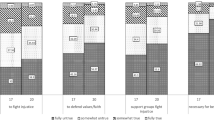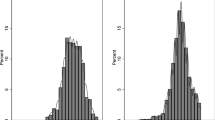Abstract
The overarching aim of this study is to understand better the over time development adolescents approval of violent political action. Using up to six waves of longitudinal survey data for two cohorts of Swedish adolescents (N = 1987), this study examined: (1) the over time development of approval of violent political means. And, (2) in mediation models, the explanatory capacity of the brooder’s route and the delinquent’s route, two theoretical explanations put forth by the literature. The results show that approval of violent political means develops as a dynamic process. Whereas indicators of both the brooder’s and the delinquent’s route were both related to approval of violent political means, only delinquency mediated (partial mediation) the over time relation of the outcome. The findings were discussed in the light of what proximity of, on the one hand, ideology or religiosity implies, and on the other, what other kinds of violence than political implies for the development of adolescents’ approval of violent political means.
Similar content being viewed by others
Notes
It would be relevant to use a moderated mediation here to examine the extent to which religiosity explains the development of violent political means differently depending on: (a) adolescents’ religious preferences, or (b) the background of adolescents (migrant background or not). However, as the low-frequency character of approval of violent political means prohibits from a reliable attempt at such analyses.
To use a framework in which the same factor functions as the independent variable and the dependent variable is uncommon practice in mediation analyses. However, following the reasoning of Agler and De Boeck (2017, p. 2), such instances can be considered mediation “in the sense that all effects are transmitted by way of an intervening effect.”
Readers interested in further examples of how approval of violent political means relates to adolescents’ background factors and independent variables can turn to Table 6 in the “Appendix”.
References
Abdelzadeh, A., M. Özdemir, and M. Van Zalk. 2015. Dissatisfied Citizens: An Asset to or a Liability on the Democratic Functioning of Society? Scandinavian Political Studies 38 (4): 410–436.
Agler, R., and P. De Boeck. 2017. On the Interpretation and Use of Mediation: Multiple Perspectives on Mediation Analysis. Frontiers in Psychology 8: 1984.
Amnå, E., M. Ekström, M. Kerr, and H. Stattin. 2009. Political Socialization and Human Agency: The Development of Civic Engagement from Adolescence to Adulthood. Statsvetenskaplig Tidskrift 111 (1): 27–40.
Bartlett, J., and C. Miller. 2012. The Edge of Violence: Towards Telling the Difference Between Violent and Non-violent Radicalization. Terrorism and Political Violence 24 (1): 1–21.
Bjørgo, T. 2011. Dreams and Disillusionment: Engagement in and Disengagement from Militant Extremist Groups. Crime, Law and Social Change 55 (4): 277–285.
Borum, R. 2011. Radicalization into Violent Extremism I: A Review of Social Science Theories. Journal of Strategic Security 4 (4): 7–36.
Caiani, M., and L. Parenti. 2009. The Dark Side of the Web: Italian Right-wing Extremist Groups and the Internet. South European Society and Politics 14 (3): 273–294.
Cohen, J. 1992. A Power Primer. Psychological Bulletin 112 (1): 155.
Corning, A.F., and D.J. Myers. 2002. Individual Orientation Toward Engagement in Social Action. Political Psychology 23 (4): 703–729.
Crone, M. 2016. Radicalization Revisited: Violence, Politics and the Skills of the Body. International Affairs 92 (3): 587–604.
Dalgaard-Nielsen, A. 2010. Violent Radicalization in Europe: What We Know and What We Do Not Know. Studies in Conflict & Terrorism 33 (9): 797–814.
Dahl, V. 2014. Breaking the law: adolescents’ involvement in illegal political activity. Ph. D. dissertation, Örebro University, Örebro.
Dahl, V., and H. Stattin. 2016. Beyond the Limits: Involvement in Illegal Political Activities. European Political Science Review 8 (01): 125–145.
Dahl, V., and M. Van Zalk. 2014. Peer Networks and the Development of Illegal Political Behavior Among Adolescents. Journal of Research on Adolescence 24 (2): 399–409.
Della Porta, D. 2013. Clandestine political violence. Cambridge: Cambridge University Press.
Enders, C.K., and D.L. Bandalos. 2001. The relative performance of full information maximum likelihood estimation for missing data in structural equation models. Structural Equation Modeling 8 (3): 430–457.
Flyghed, J. 2013. Policing of Political Protest. The Security Police’s Control of the Extra-parliamentary Opposition in Sweden During and after the Cold War. Journal of Scandinavian Studies in Criminology and Crime Prevention 14 (supp1): 81–99.
Galtung, J. 1990. Cultural Violence. Journal of Peace Research 27 (3): 291–305.
Harbisher, B. 2015. Unthinking Extremism: Radicalising Narratives that Legitimise Surveillance. Surveillance & Society 13 (3/4): 474.
Hemmingsen, A.-S., M. Crone, and P.J. Witt. 2015. The Politicisation of Violence: An Alternative to Radicalization, DIIS Policy Brief. Copenhagen: Danish Institute for International Studies.
Horgan, J. 2008. From Profiles to Pathways and Roots to Routes: Perspectives from Psychology on Radicalization into Terrorism. The Annals of the American Academy of Political and Social Science 618 (1): 80–94.
Jackson, J., A.Z. Huq, B. Bradford, and T.R. Tyler. 2013. Monopolizing Force? Police Legitimacy and Public Attitudes Toward the Acceptability of Violence. Psychology, Public Policy, and Law 19 (4): 479–497.
Kerr, M., and H. Stattin. 2000. What Parents Know, How They Know it, and Several Forms of Adolescent Adjustment: Further Support for a Reinterpretation of Monitoring. Developmental Psychology 36 (3): 366.
Kuhn, H.P. 2004. Adolescent Voting for Right-Wing Extremist Parties and Readiness to Use Violence in Political Action: Parent and Peer Contexts. Journal of Adolescence 27 (5): 561–581.
Kundnani, A. 2012. Radicalisation: The Journey of a Concept. Race & Class 54 (2): 3–25.
MacKinnon, D.P. 2008. Introduction to Statistical Mediation Analysis. New York: Routledge.
Mallinckrodt, B., W.T. Abraham, M. Wei, and D.W. Russell. 2006. Advances in Testing the Statistical Significance of Mediation Effects. Journal of Counseling Psychology 53 (3): 372.
McCauley, C., and S. Moskalenko. 2008. Mechanisms of Political Radicalization: Pathways Toward Terrorism. Terrorism and Political Violence 20 (3): 415–433.
McCauley, C., and S. Moskalenko. 2017. Understanding Political Radicalization: The Two-Pyramids Model. American Psychologist 72 (3): 205–216.
Moskalenko, S., and C. McCauley. 2009. Measuring Political Mobilization: The Distinction Between Activism and Radicalism. Terrorism and Political Violence 21 (2): 239–260.
Murer, J. 2014. Understanding Collective Violence: The Communicative and Performative Qualities of Violence in Acts of Belonging. In Ilias Bantekas (Ed.), International Criminal Law and Criminology (pp. 287–315).
Muthén, B.O. 2011. Applications of causally defined direct and indirect effects in mediation analysis using SEM in Mplus. Unpublished manuscript. Retrieved from http://www.statmodel.com/download/causalmediation.pdf.
Muthén, L., and B. Muthén. 1998–2010. Mplus user’s guide (6th ed.). Los Angeles, CA: Muthén & Muthén.
Neumann, P.R. 2013. The Trouble with Radicalization. International Affairs 89 (4): 873–893.
Rink, A., and K. Sharma. 2016. The Determinants of Religious Radicalization: Evidence from Kenya. Journal of Conflict Resolution 62 (6): 1–33.
Schils, N., and A. Verhage. 2017. Understanding How and Why Young People Enter Radical or Violent Extremist Groups. International Journal of Conflict and Violence 11 (1): 1–17.
Shechory, M., and A. Laufer. 2008. Social Control Theory and the Connection with Ideological Offenders Among Israeli Youth During the Gaza Disengagement Period. International Journal of Offender Therapy and Comparative Criminology 52 (4): 454–473.
Stankov, L., G. Saucier, and G. Knežević. 2010. Militant Extremist Mind-set: Proviolence, Vile World, and Divine Power. Psychological Assessment 22 (1): 70.
Statistics Sweden. 2012. Antal personer med utländsk eller svensk bakgrund efter region. Retrieved 27/3/2013, from Statistics Sweden http://www.scb.se.
Van Hiel, A. 2012. A Psycho-Political Profile of Party Activists and Left-Wing and Right-Wing Extremists. European Journal of Political Research 51 (2): 166–203.
Watts, M.W. 1999. Are There Typical Age Curves in Political Behavior? The “Age Invariance” Hypothesis and Political Socialization. Political Psychology 20 (3): 477–499.
Wiktorowicz, Q. 2005. Radical Islam Rising: Muslim Extremism in the West. Rowman & Littlefield Publishers.
Acknowledgements
This study was made possible by access to data from the Political Socialization Program, a longitudinal research program at YeS (Youth and Society) at Örebro University, Sweden. Responsible for the planning, implementation and financing of the collection of data were professors Erik Amnå, Mats Ekström, Margaret Kerr and Håkan Stattin. The data collection was supported by grants from Riksbankens Jubileumsfond. The study was also financially supported by the Swedish Research Council for Health, Working Life and Welfare (Forte: 2015 00991).
Author information
Authors and Affiliations
Corresponding author
Additional information
Publisher's Note
Springer Nature remains neutral with regard to jurisdictional claims in published maps and institutional affiliations.
Rights and permissions
About this article
Cite this article
Dahl, V. Adolescents’ development of approval of violent political action: evidence from six waves of longitudinal data. Acta Polit 55, 538–559 (2020). https://doi.org/10.1057/s41269-019-00130-x
Published:
Issue Date:
DOI: https://doi.org/10.1057/s41269-019-00130-x







